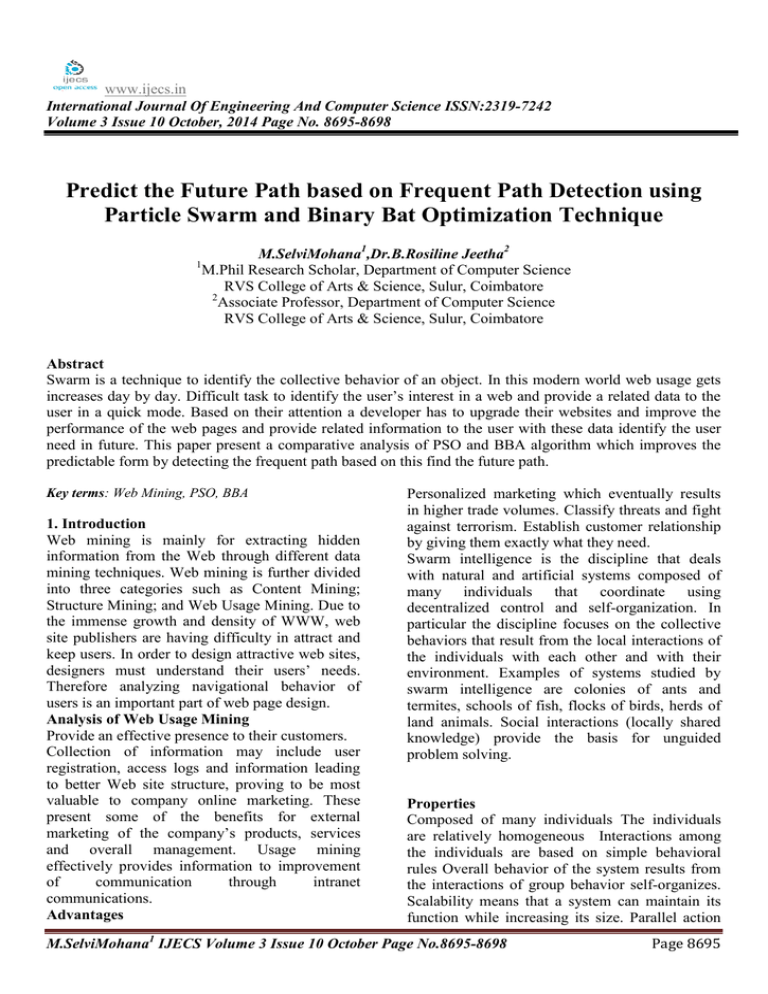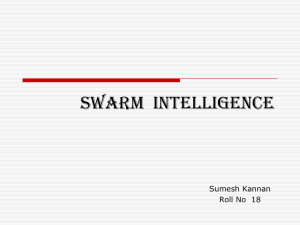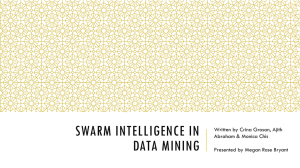www.ijecs.in International Journal Of Engineering And Computer Science ISSN:2319-7242
advertisement

www.ijecs.in International Journal Of Engineering And Computer Science ISSN:2319-7242 Volume 3 Issue 10 October, 2014 Page No. 8695-8698 Predict the Future Path based on Frequent Path Detection using Particle Swarm and Binary Bat Optimization Technique 1 M.SelviMohana1,Dr.B.Rosiline Jeetha2 M.Phil Research Scholar, Department of Computer Science RVS College of Arts & Science, Sulur, Coimbatore 2 Associate Professor, Department of Computer Science RVS College of Arts & Science, Sulur, Coimbatore Abstract Swarm is a technique to identify the collective behavior of an object. In this modern world web usage gets increases day by day. Difficult task to identify the user’s interest in a web and provide a related data to the user in a quick mode. Based on their attention a developer has to upgrade their websites and improve the performance of the web pages and provide related information to the user with these data identify the user need in future. This paper present a comparative analysis of PSO and BBA algorithm which improves the predictable form by detecting the frequent path based on this find the future path. Key terms: Web Mining, PSO, BBA 1. Introduction Web mining is mainly for extracting hidden information from the Web through different data mining techniques. Web mining is further divided into three categories such as Content Mining; Structure Mining; and Web Usage Mining. Due to the immense growth and density of WWW, web site publishers are having difficulty in attract and keep users. In order to design attractive web sites, designers must understand their users’ needs. Therefore analyzing navigational behavior of users is an important part of web page design. Analysis of Web Usage Mining Provide an effective presence to their customers. Collection of information may include user registration, access logs and information leading to better Web site structure, proving to be most valuable to company online marketing. These present some of the benefits for external marketing of the company’s products, services and overall management. Usage mining effectively provides information to improvement of communication through intranet communications. Advantages Personalized marketing which eventually results in higher trade volumes. Classify threats and fight against terrorism. Establish customer relationship by giving them exactly what they need. Swarm intelligence is the discipline that deals with natural and artificial systems composed of many individuals that coordinate using decentralized control and self-organization. In particular the discipline focuses on the collective behaviors that result from the local interactions of the individuals with each other and with their environment. Examples of systems studied by swarm intelligence are colonies of ants and termites, schools of fish, flocks of birds, herds of land animals. Social interactions (locally shared knowledge) provide the basis for unguided problem solving. Properties Composed of many individuals The individuals are relatively homogeneous Interactions among the individuals are based on simple behavioral rules Overall behavior of the system results from the interactions of group behavior self-organizes. Scalability means that a system can maintain its function while increasing its size. Parallel action M.SelviMohana1 IJECS Volume 3 Issue 10 October Page No.8695-8698 Page 8695 is possible in swarm intelligence systems because individuals composing the swarm can perform different actions in different places at the same time. Fault tolerance is an inherent property of swarm intelligence systems due to the decentralized, self-organized nature of their control structures. This paper presents a comparative analysis of PSO and BBA algorithm which improves the predictable form by detecting the frequent way using solution obtained by the group of objects. This approach provides a flexible solution that incorporates multidimensional search space to provide frequent path identification. The performances of these techniques are evaluated using speed and position. This dissertation presents a comparative analysis of these optimization techniques which deals with accuracy and frequency score. ants as they find their fastest path back to their nest when sourcing for food. Particle swarm optimization technique deals with the collective behavior of birds flocking together. Bat algorithm it uses bat echo location to find the prey with loudness and pulse rate and it is only continuous valued. Binary bat algorithm uses binary string length along with set of binary coordinates to evaluating the set. Swarm technique is based on the collective behaviors of insects with effect from the local relations of the individuals with each other and with their environment.web usage mining is to know about the user behavior either individual or group so implement the swarm techniques through that easily identify the user behavior 2. Review of Literature 1.[Seema C.P and Dr. Pradeep Chouksey] ”Hybrid Framework Using Ant Colony Clustering and KMeans Genetic Algorithm (Ant-Kga) For Optimizations of Web Usage Pattern” present a comparative performance evaluation model of ANT-LGP versus ANT-KGA by means of an analytical approach. Quantitative measurements are performed using number clusters, error rate, number of iteration and execution time performance parameters in this work. Test the false positive rates in which a clustering is presented with a large number of samples that do not belong to any of cluster. Error rate is major factor for calculating performance. (Ant-KGA) algorithm executed on different threshold values to identify its scalability. 2.[Xiaohua Hu] “Analysis of Browsing Behaviors with Ant Colony Clustering Algorithm” paper introduces an optimized ant colony clustering algorithm (OACA) in dynamic pattern discovery, and explores the structured formula to describe the users’ browsing behavior patterns as well as to analyze their characteristics adaptively. Three components can be used to find the behavior User component, Behavior component and Web Site component 3.[Akshay Kansara] “Improved Approach to Predict user Future Sessions using Classification and Clustering” The objective of Predicting User navigation patterns using Clustering and Classification from web log data is to predict user navigation patterns using knowledge from the classification process that identifies potential users from web log data and a clustering process that groups potential users with similar interest and using the results of classification and clustering, predict future user requests. K Means algorithm creates first random cluster for that it runs different times and each time it starts from a different point and computes different results. All the clusters are compared using the distances within clusters and the least sum of distances is considered. as a result, k-means algorithm deals with the total number of clusters (k), the total number of runs and the distance measured. Output defines total number of clusters with actual number of items in each cluster. Distance measured between all data sets in each cluster plays a crucial role in the clusters 4.[Ajith Abraham] “Web Usage Mining Using Artificial Ant Colony Clustering and Genetic Programming” propose an ant clustering algorithm to discover Web usage patterns (data clusters) and a linear genetic programming approach to analyze the visitor trends to analyze the hourly and daily web traffic volume. 5.[V.Selvi] “Comparative Analysis of Ant Colony and Particle Swarm Optimization Techniques” focuses on the comparative analysis of most successful methods of optimization techniques inspired by Swarm Intelligence (SI) : Ant Colony Optimization (ACO) and Particle Swarm Optimization (PSO). An elaborate comparative analysis is carried out to endow these algorithms with fitness sharing, aiming to investigate whether this improves performance which can be implemented in the evolutionary algorithms. 6.[R.Rathipriya] “Binary Particle Swarm Optimization based Biclustering of Web usage Data” The main objective of this algorithm is to retrieve the global optimal bicluster from the web usage data. These biclusters contain relationships M.SelviMohana1 IJECS Volume 3 Issue 10 October Page No.8695-8698 Page 8696 between web users and web pages which are useful for the E-Commerce applications like web advertising and marketing .To identify the maximal subset of users which shows similar browsing pattern under a specific subset of pages. 3. Particle Swarm Optimization PSO is methods which utilize the set of agents that move through the search space to find the global minimum objective function. The particle moves according to the coordinates and velocity of the object. It is based on the research of bird and fish flock movement behavior. While searching for food, the birds are either scattered or go together before they locate the place where they can find the food. While the birds are searching for food from one place to another, there is always a bird that can smell the food very well, that is, the bird The position of each particle in the swarm is affected both by the most optimist position during its movement (individual experience) and the 4. Binary Bat Binary version of the Bat Algorithm called BBA, in which the search space is modelled as a cube, where stands for the number of features. In such case, the optimal (nearoptimal) solution is chosen among the 2 possibilities, and it correspond to one hyper cube’s corner. The main idea is to associate for each bat a set of binary coordinates that denote whether a solution will belong to the final set of value or not. The function to be maximized is the one given by a supervised grouping accuracy. As the quality of the solution is related with the number of bats, we need to evaluate each one of them by evaluating position 5. Experimental Result Comparative analyses of particle swarm optimization technique and Binary bat technique with respect to several parameters; Speed of the particle, Position of the particle in PSO, Loudness of bat, Frequency, Pulse Rate of the bat in Binary bat. Both these techniques have correlated parameters so to analyze the performance level of is observable of the place where the food can be found, having the better food resource information. To achieve the solution with higher probability. Initially, a population of particles is distributed uniformly in the multi-dimension search space of the objective function of the optimization problem. Two quantities are associated with particles, a position and a velocity. In the basic particle swarm optimization algorithm, particle swarm consists of “n” particles, and the position of each particle stands for the potential solution in D-dimensional space. The particles change its condition according to the following three principles:(1) to keep its inertia (2) to change the condition according to its most optimist position (3) to change the condition according to the swarm’s most optimistic position. position of the most optimist particle in its surrounding (near experience). with the selected solution fixed by the bat’s position and also to organize an evaluating set. In BBA, the velocity is calculated for each single feature; hence, the algorithm is more timeconsuming and departing from the original algorithm attitude time difference between their two ears to obtain three-dimensional information, they can identify the type of prey and the velocity of a flying insect. Each bat position is formulated as a binary string of length , where is the total number of path generated. Each path is represented by bit, where “1” means that the corresponding frequent path is selected and the “0” means that it is not frequent path. these techniques gives the value of find the frequent path based on this solution we can predicted the future path. Compare these optimization techniques with different number of generations. The different parameters may results in slightly vary performance the fundamental behavior of these techniques remains speed and position Number of evaluations: 1 fmin=4 Number of evaluations: 2 fmin=4 Number of evaluations: 3 fmin=4 Number of evaluations: 4 fmin=4 M.SelviMohana1 IJECS Volume 3 Issue 10 October Page No.8695-8698 Page 8697 Generation (5, 10, 15,20) Score (1.001 – 1.002) BBA and PSO having a similar parameters position and speed in pso and loudness and pulse rate in bba.BBA algorithm it takes binary bit values bit 1 means all the bats are goes in similar path bit 0 means no similar path path varies depends on the bats.PSO have pbest and gbest pso takes random values range (0,1).The results shows pso tested with generations (5,10,15, 20, 25, 30) the point lies in between 0.65 to 1 Global solution can be found if only input values are stable . In bba it tested with iteration (5, 10, 15, 20, 25) in all the iteration to evaluate that the points will be lies in a same point. Once it reaches the final value it always goes in a same path so pso varies between 0,1 but in bba it always lies in a same way if its having high pulse emission rate. These two algorithms can be implemented in any domain to identify the frequent usage level. 6.Findings In this dissertation, identifying the frequent path with similar interest of user. Complexity to analyze the user need. User requirements and their interests are most important factor in the development of business. Identifying the user frequent usage path is the only way to provide the related information to the user and develop the website. The main objective is to compare particle swarm optimization and binary bat optimization techniques to discover the user frequent path. The experimental results prove that these techniques are efficient in terms of accuracy, speed and position and wavelength 6.1 PSO Findings a) Particle swarm optimization technique has Weight, speed and position of the particle, b) Continuous valued optimization, c) Frequent path lies between 0, 1, d) Change the movement according to the velocity of the particles, e) Either individual movement or neighboring movement, f) Mainly for avoiding collision, g) Very fast, h) Frequent path lies between 0.65 and 1.02 6.2 BBA Findings M.SelviMohana1 IJECS Volume 3 Issue 10 October Page No.8695-8698 Page 8698 The main idea is to associate for each bat a set of binary coordinates that denote whether a solution will belong to the final set of value or not. a) Binary Bat is an Discrete Optimization b) Binary Bat optimization has loudness and pulse rate, c) Binary coordinates can be used, d) Frequent path lies in a same path , e) When its pulse rate will be high and loudness will be low. f) If bit value ‘1’ pulse rate high bats reaches the prey and all the bats travelled in same path g) bit value ‘0’ means loudness gets increase and there is no frequent path. These two techniques have different opinions and results and it can be implemented in different websites to identify the frequent user, frequent path of the user and frequent webpage access. In future these techniques can be implemented in different domains and gives rise to several interesting directions for future research. 7. Conclusion Compare multiple swarm techniques has recently attracted the many researchers in web usage mining. In different approaches for combining swarm based on graph-partitioning are proposed and evaluated. Swarm intelligence plays an important role to know about the individual or group of user’s opinion. The main objective of Predicting User frequent Path using Particle Swarm Optimization and Binary Bat Algorithm is to discover frequent path with similar interest of user and using the results of these techniques to identify the accuracy and frequent way usage with these came to know about the users searching view in future. Evaluate these algorithms with speed and position. In future it will be implemented in different domains. 7. References 1. Bamshad Mobasher, “Automatic Personalization Based on Web Usage Mining” August 2000 Communications of the Acm 2. K. Thangavel, “Mining Correlated Bicluster from Web Usage Data Using Discrete Firefly Algorithm Based Biclustering Approach”, International Journal of Mathematical, Computational, Physical and Quantum Engineering,2014 3. R.Rathipriya, “Binary Particle Swarm Optimization based Biclustering of Web usage Data”, International Journal of Computer Applications ,2011 4. Prof. V.V.R. Maheswara Rao, “An Advanced Optimal Web Intelligent Model for Mining Web User Usage Behavior using Genetic Algorithm”, ACEEE Int. J. on Network Security, 2010 5. Lu DaiAn, “Efficient Web Usage Mining Approach Using Chaos Optimization and Particle Swarm Optimization Algorithm Based on Optimal Feedback Model”, Hindawi Publishing Corporation Mathematical Problems in Engineering Volume 2013, Article ID 340480 6.C. Ramos, “A novel algorithm for feature selection using harmony search and its application for non-technical losses detection,” Computers & Electrical Engineering, vol. 37, no. 6, pp. 886– 894, 2011. 7.H. R. Kanan, K. Faez, and S. M. Taheri, “Feature selection using ant colony optimization (ACO): a new method and comparative study in the application of face recognition system,” in Proceedings of the 7th industrial conference on Advances in data mining: theoretical aspects and applications. Berlin, Heidelberg: Springer-Verlag, 2007, pp. 63–76. 8.Ebru TURANOĞLUa “Particle Swarm Optimization And Artificial Bee Colony Approaches To Optimize Of Single Input-Output Fuzzy Membership Functions”, Proceedings of the 41st International Conference on Computers & Industrial Engineering. M.SelviMohana1 IJECS Volume 3 Issue 10 October Page No.8695-8698 Page 8699







